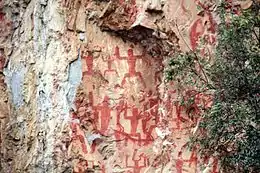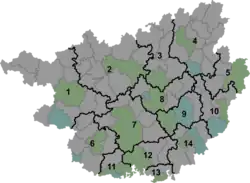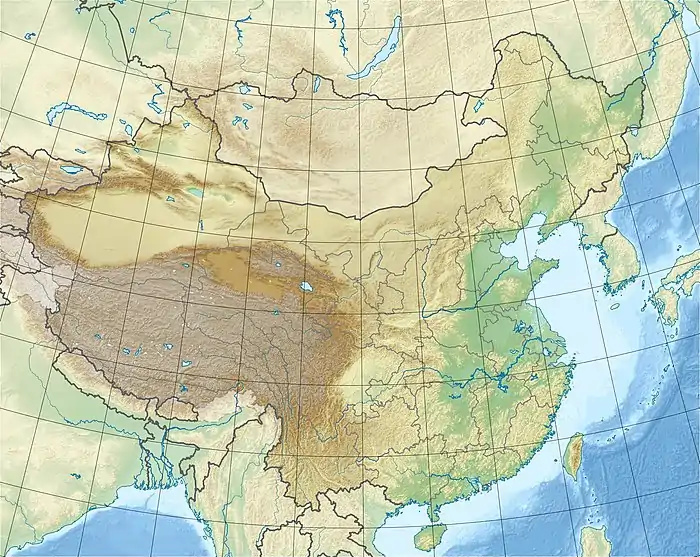Zuojiang Huashan Rock Art
The Zuojiang Huashan Rock Art Cultural Landscape (Chinese: 花山壁画; pinyin: Huāshān Bìhuà) is an extensive assembly of historical rock art that were painted on limestone cliff faces in Guangxi, southern China. The paintings are located on the west bank of the Ming River (Chinese: 明江; pinyin: Míng Jiāng; lit. 'Bright River') which is a tributary of the Zuo River.[1] The area of the paintings is part of the Nonggang Nature Reserve[1] and belongs to Ningming County.[2] On July 15, 2016, Zuojiang Huashan Rock Art Cultural Landscape was listed as the 49th UNESCO World Heritage Site in China.[2]
| UNESCO World Heritage Site | |
|---|---|
 Detail of the main painting | |
| Location | Guangxi, China |
| Includes |
|
| Criteria | Cultural: (iii), (vi) |
| Reference | 1508 |
| Inscription | 2016 (40th Session) |
| Area | 6,621.6 ha (16,362 acres) |
| Buffer zone | 12,149.0 ha (30,021 acres) |
| Coordinates | 22°15′20″N 107°1′23″E |
 Location of Zuojiang Huashan Rock Art in Guangxi  Zuojiang Huashan Rock Art (China) | |
The main painted area along the cliff has a width of about 170 metres (560 ft) and a height of about 40 metres (130 ft)[3] and is one of the largest rock paintings in China.[3] The paintings are located between 30 metres (98 ft) and 90 metres (300 ft) above the river's water level.[1] The main area contains about 1900 discrete countable images arranged in about 110 groups.[3] The paintings have a red color and were executed using a mixture of red ochre (hematite), animal glue, and blood.[3] They depict human figures as well as animals along with bronze drums, knives, swords, bells, and ships.[1] Human figures are typically between 60 centimetres (24 in) and 150 centimetres (4.9 ft) tall, but one figure reaches 3 metres (9.8 ft) in height.[1]
The painting's were originally thought to date from the period around the 5th century BCE, to the 2nd century CE. However, recent carbon dating suggests that the oldest paintings were executed around 16,000 years ago. Whereas the youngest are around 690 years old.[1] The period of their creations spans the times from the Warring States period to the late Han Dynasty in the history of China. Many of the paintings are thought to "illustrate the life and rituals" of the ancient Luo Yue people, who inhabited the valley of Zuo River during this period[1] and are believed to be ancestors of Zhuang people,[2][3] Muong people and Kinh people.[4]
An exhibition in the Zhuang Nationality Museum in the City of Chongzuo (崇左市壮族博物馆) is dedicated to the history and interpretation of the paintings.
References
- Guo Hong, Han Rubin, Huang Huaiwu, Lan Riyong, and Xie Riwan Types of Weathering of the Huashan Rock Paintings, in: Agnew, Neville, ed., Conservation of Ancient Sites on the Silk Road: Proceedings of the Second International Conference on the Conservation of Grotto Sites, Mogao Grottoes, Dunhuang, People's Republic of China, June 28-July 3, 2004. Los Angeles: The Getty Conservation Institute, 2010. Archived from original
- "Zuojiang Huashan Rock Art Cultural Landscape - UNESCO World Heritage". www.chinadiscovery.com. Retrieved 2020-01-20.
- "The Rock Painting of the Mountain Huashan - UNESCO World Heritage Tentative List". Archived from original
- Gao, Qian (April 2013). "Gao, Q. 2013. The Huashan rock art site (China) – the sacred meeting place for sky, water and earth. Rock Art Research 30: 22-32". Rock Art Research.